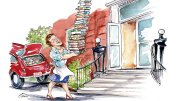Every year, French wholesalers airlift cases of Beaujolais Nouveau worldwide so that wine shops can start selling bottles to the public on the third Thursday in November. In the unlikely event that the contents have not traveled well, a customer merely returns on Friday and exchanges the spoiled bottle for a fresh one.
Life was not so easy for the fifteenth-century wine lover. Many oenophiles had no local wine merchants, nor even corks and bottles, which did not appear until the 1700s. Take John Whittocksmead, a local dignitary in Wiltshire, England, who ordered French wine by the tun (a shipping barrel that contained 252 gallons and weighed about 2,000 pounds, hence, a "ton"). Think how this gigantic vat might have traveled. After weathering a stormy 10-day December passage from Bordeaux to Bristol, it was jolted by oxcart to the manor of Melksham Beanacre, where Whittocksmead might have stood by in the wine cellar while the tun was tapped and its contents first tasted. Was the wine cloudy, musty, too young, too pale?
If so, the owner had a ton of bad wine on his hands, and no easy way to return it. Yet there were traditional remedies aplenty, as detailed in the "Wagstaff Miscellany," a manuscript signed in the margin by the erstwhile owner, Whittocksmead himself. "The manuscript is a household encyclopedia. Reading it is like looking at someone's diary or scrapbook," says medievalist Mary-Jo Arn, a visiting scholar in the department of English and American literature and language. Of particular interest to Arn are 13 recipes for rectifying spoiled wine, cures that she discussed earlier this year in a lecture at Harvard entitled "Good Wine from Bad," and previously described in a 1990 Yale University Library Gazette article on "The Emendation of Wine." She hopes to explore the scientific implications of the formulas in the "Wagstaff Miscellany" and other manuscripts, and to this end has accumulated some 300 wine-curing recipes in eight languages. "Neither wine problems nor wine solutions are new," says Arn, "but classical and modern techniques are much more fully documented than medieval ones. I'd like to complete the chain of knowledge."
Arn stresses the practical nature of these formulas, "though they seem quaint and strange." Wine that has been traumatized, for example, is often turbid. A week or two of rest should do the trick. If the condition persists due to floating sediment, the miscellany has an answer: "Take lx eggez and breke them in a vessell wyth a hanfulle of grete [coarse] salt and bete them welle." Add some spikenard (an aromatic herb) "and put alle thees in-to the tonne, and he shalle be fyne a-none [at once]."
One might be tempted to dismiss such advice as an old wives' tale, simply because it was recorded in the days before oenology was even a word, much less a field of graduate study. Arn, however, has duplicated the process successfully in her own kitchen. First she clouded a sample of wine by pouring in some orange juice. Then she unclouded it by adding beaten eggs and salt and letting the wine stand overnight. ("Milk is also a good fining [clarifying] substance," she says.) Although she had no spikenard handy, the offending particles, along with the reagents, nonetheless precipitated out; the decanted wine retained its taste, only slightly affected by the purifying treatment.
The manuscript's suggestions for musty or fusty wine smack of cosmetic cover-up. One recommends adding galingale, also an aromatic herb; another calls for ginger and turmeric. Interestingly, all of these, or their close kin, are used today to flavor vermouth.
Another recipe addresses the problem of "wyne that is to grene," and therefore sharp in taste, with low alcohol content. Crossing the English Channel in winter might well inhibit its fermentation. The answer: mix honey with wine and pour it into the tun, to encourage further ferment. Or pour a pan of boiling wine into the barrel, to raise the temperature a degree or two and encourage alcohol production. When spring came and the cellar warmed, the medieval tippler faced the opposite problem: unwanted fermentation. For this, the miscellany suggests powdering beans, placing them in a cloth bag, and dipping this into the tun. Arn points out that beans and other recommended starches are alkaline; they would lower the acidity and cause fermentation to fizzle out.
Medieval Englishmen liked their red wine red, and disdained any pale substitutes sent over by the French. "For wyne that is jawndez" there were three treatments: spike it with robust "vino tinto" from Spain; crush blackberries, put them in a bag, and dip it into the tun to darken the wine's color; or pound "kermes," steep it, and add it to the wine. Kermes was a berry-shaped organic product used as a red dye by clothiers. Some Harvardians may want to raise a toast when they learn that the word is the source of our word "crimson." A possible caveat: kermes consisted of the swollen abdomens of female insects that infested the scarlet oaks of southern Europe. Another round, anyone?
~Peter H. Desmond





